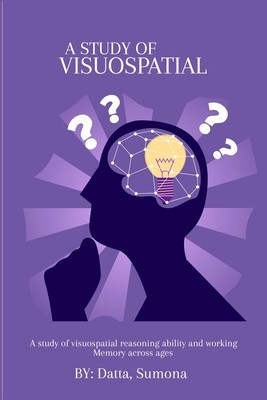
- Išsiųsime per 10–14 d.d.
- Autorius: Datta Sumona
- Leidėjas: Mab-India
- ISBN-10: 4299539338
- ISBN-13: 9784299539335
- Formatas: 15.2 x 22.9 x 2 cm, minkšti viršeliai
- Kalba: Anglų
- Extra -15 % nuolaida šiai knygai su kodu: ENG15
A study on visuospatial reasoning ability and working memory across ages + nemokamas atvežimas! | knygos.lt
Atsiliepimai
Aprašymas
Abstract Visuospatial reasoning is the ability to manipulate visuospatial information in order to reason out logical inferences based on the given information. There are three static and one dynamic visuospatial reasoning ability namely, Mental Rotation-based reasoning, Spatial Orientationbased reasoning, Spatial Visualization-based reasoning and Dynamic Visualization ability respectively. Literature review revealed a gap of knowledge about development of visuospatial reasoning abilities during pre-adolescence and adolescence. Moreover, relationship between visuospatial reasoning abilities and working memory is little understood although working memory plays important role in the functioning of visuospatial reasoning abilities. Cognitive development of children is also largely influenced by their home climate. However, home influences on the functioning of visuospatial reasoning abilities are hardly explored. Present study has three objectives: (i) to develop a test battery for assessing Visuospatial Reasoning abilities, (ii) to examine relation among Visuospatial Reasoning abilities, Working Memory and Home Climate & (iii) to examine age wise differences in Visuospatial Reasoning abilities and Working Memory components across pre-adolescence and adolescence. Five separate pilot studies (n1:147; n2:51; nj:93; na:27; n5:752) were conducted for the development and validation of the test battery. The visuospatial reasoning tests have sufficient internal consistency, test-retest reliability, splirhalf reliability and adequate validity indices. For the main study, data were collected from 792 typically developing children of 7-16 years (Mean age:11.55 years; SD:2.87) from Kolkata metro city and suburban area. The newly developed Visuospatial Reasoning test battery, Digit span and Corsi span tasks and Home Environment Inventory (Mishra, 1989) were administered to
EXTRA 15 % nuolaida su kodu: ENG15
Akcija baigiasi už 1d.10:37:24
Nuolaidos kodas galioja perkant nuo 10 €. Nuolaidos nesumuojamos.

- Autorius: Datta Sumona
- Leidėjas: Mab-India
- ISBN-10: 4299539338
- ISBN-13: 9784299539335
- Formatas: 15.2 x 22.9 x 2 cm, minkšti viršeliai
- Kalba: Anglų
Abstract Visuospatial reasoning is the ability to manipulate visuospatial information in order to reason out logical inferences based on the given information. There are three static and one dynamic visuospatial reasoning ability namely, Mental Rotation-based reasoning, Spatial Orientationbased reasoning, Spatial Visualization-based reasoning and Dynamic Visualization ability respectively. Literature review revealed a gap of knowledge about development of visuospatial reasoning abilities during pre-adolescence and adolescence. Moreover, relationship between visuospatial reasoning abilities and working memory is little understood although working memory plays important role in the functioning of visuospatial reasoning abilities. Cognitive development of children is also largely influenced by their home climate. However, home influences on the functioning of visuospatial reasoning abilities are hardly explored. Present study has three objectives: (i) to develop a test battery for assessing Visuospatial Reasoning abilities, (ii) to examine relation among Visuospatial Reasoning abilities, Working Memory and Home Climate & (iii) to examine age wise differences in Visuospatial Reasoning abilities and Working Memory components across pre-adolescence and adolescence. Five separate pilot studies (n1:147; n2:51; nj:93; na:27; n5:752) were conducted for the development and validation of the test battery. The visuospatial reasoning tests have sufficient internal consistency, test-retest reliability, splirhalf reliability and adequate validity indices. For the main study, data were collected from 792 typically developing children of 7-16 years (Mean age:11.55 years; SD:2.87) from Kolkata metro city and suburban area. The newly developed Visuospatial Reasoning test battery, Digit span and Corsi span tasks and Home Environment Inventory (Mishra, 1989) were administered to




Atsiliepimai